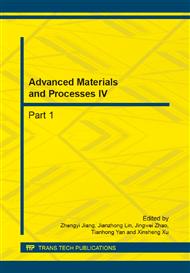[1]
Andolfatto, Loïc, Sylvain Lavernhe, and J. R. R. Mayer. Evaluation of servo, geometric and dynamic error sources on five-axis high-speed machine tool., International Journal of Machine Tools and Manufacture 51. 10 (2011): 787-796.
DOI: 10.1016/j.ijmachtools.2011.07.002
Google Scholar
[2]
Slamani, Mohamed, Rene Mayer, and Marek Balazinski. Concept for the integration of geometric and servo dynamic errors for predicting volumetric errors in five-axis high-speed machine tools: an application on a XYC three-axis motion trajectory using programmed end point constraint measurements., The International Journal of Advanced Manufacturing Technology 65. 9-12 (2013).
DOI: 10.1007/s00170-012-4289-7
Google Scholar
[3]
Chen, Jian-xiong, Shu-wen Lin, and Bing-wei He. Geometric error measurement and identification for rotary table of multi-axis machine tool using double ballbar., International Journal of Machine Tools and Manufacture 77 (2014): 47-55.
DOI: 10.1016/j.ijmachtools.2013.10.004
Google Scholar
[4]
Gomez-Acedo, Eneko, et al. Methodology for the design of a thermal distortion compensation for large machine tools based in state-space representation with Kalman filter., International Journal of Machine Tools and Manufacture 75 (2013): 100-108.
DOI: 10.1016/j.ijmachtools.2013.09.005
Google Scholar
[5]
Miao, En-Ming, et al. Robustness of thermal error compensation modeling models of CNC machine tools., The International Journal of Advanced Manufacturing Technology 69. 9-12 (2013): 2593-2603.
DOI: 10.1007/s00170-013-5229-x
Google Scholar
[6]
Karimi, Davoud, and Mohammad J. Nategh. Development of a novel adaptive nonuniform rational basis spline interpolator with limited kinematic error for hexapod machine tools., Proceedings of the Institution of Mechanical Engineers, Part B: Journal of Engineering Manufacture (2013).
DOI: 10.1177/0954405413493268
Google Scholar
[7]
Wu, H., et al. Modelling and real-time compensation of cutting-force-induced error on a numerical control twin-spindle lathe., Proceedings of the Institution of Mechanical Engineers, Part B: Journal of Engineering Manufacture 224. 4 (2010).
DOI: 10.1243/09544054jem1641
Google Scholar
[8]
Wang, Zheng, and Paul G. Maropolous. Real-time error compensation of a three-axis machine tool using a laser tracker., The International Journal of Advanced Manufacturing Technology 69. 1-4 (2013): 919-933.
DOI: 10.1007/s00170-013-5019-5
Google Scholar


